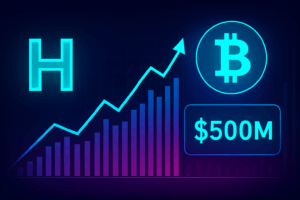Summary:
According to the Hyperliquid interface, its newly launched HIP-3 custom markets saw more than US$500 million in trading volume in the past 24 hours. The surge is largely driven by three market segments — XYZ, FLX, and VNTI — which together support over 20 tokenized assets. Among them, XYZ100 captured US$320 million in volume, while tokenized equities such as NVDA and GOOGL posted US$66 million and US$45 million, respectively.
What Is HIP-3 & Why It’s Gaining Traction
- The HIP-3 upgrade on Hyperliquid enables permissionless creation of perpetual markets, allowing anyone who stakes 500,000 HYPE (the platform’s native token) to launch new derivatives markets.
- As part of a “Growth Mode,” HIP-3 markets benefit from dramatically reduced taker fees — cut by more than 90%, down to as low as 0.00144% for top traders — helping to attract liquidity quickly.
- This permissionless model shifts market creation from being tightly controlled to a more decentralized structure, promoting innovation and rapidly scaling the number of tradable assets.
Market Breakdown & Volume Highlights
- XYZ100, an index tracking major equities launched under HIP-3, dominated trading volume with US$320 millionin 24-hour activity.
- NVDA-PERP, a perpetual market representing tokenized Nvidia stock, saw approximately US$66 million traded in that same timeframe.
- GOOGL-equivalent perpetuals also pulled in volume, reportedly around US$45 million over the day.
- In total, HIP-3 markets now cover 20+ tokens across various segments (equities, indexes, and more), reflecting strong builder and trader demand.
Why This Matters
- DeFi Bridging to Traditional Markets: With tokenized versions of real-world equities like NVDA and GOOGL, Hyperliquid is helping bridge traditional finance and crypto derivatives through fully on-chain market structures.
- Liquidity & Capital Efficiency: The dramatic fee reductions under “growth mode” are incentivizing both market makers and traders, driving enormous volume.
- Decentralized Innovation: By letting any qualified builder spin up markets, Hyperliquid may accelerate the development of niche or exotic perpetuals, potentially outpacing centralized exchanges.
- Market Diversification: Instead of relying solely on crypto tokens, HIP-3 is enabling derivatives on equities — broadening use-cases and attracting more traditional capital into DeFi.
Risks & What to Watch
- Counterparty & Smart-Contract Risk: Permissionless market creation is powerful but could expose users to risks if builders fail to maintain liquidity or properly configure oracles.
- Volatility & Leverage: Equity-based perpetuals can be highly volatile, especially under leverage, which may lead to sharp price swings or liquidations.
- Sustainability of Volume: While 24-hour volume is impressive, sustaining such levels will depend on continued builder activity, trader retention, and market maker incentives.
- Regulatory Scrutiny: Tokenization of equities — especially perpetuals — could draw attention from regulators, raising compliance challenges.
What’s Next
- New Market Launches: Further expansion is likely, with more equities, indexes, and perhaps even other asset classes being tokenized under HIP-3.
- User Growth Metrics: Watch for on-chain data showing number of new wallets, open interest trends, and liquidity per market.
- Fee and Incentive Evolution: How long “growth mode” incentives last could significantly impact future volume and adoption.
- Regulatory Developments: Whether regulators take stances on tokenized equity perp markets — especially around securities law — will be a key factor.
Bottom Line:
Hyperliquid’s HIP-3 framework is proving to be a powerful accelerator for decentralized derivatives, especially for tokenized equity markets. With over US$500 million in 24-hour trading volume, permissionless perps like XYZ100, NVDA, and GOOGL are not just experiments — they may represent a real step toward merging traditional finance with on-chain trading infrastructure.
Also Check: Texas Becomes First U.S. State to Buy Bitcoin via BlackRock ETF — Paves Way for State Bitcoin Reserve
9K4EA07P
